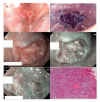Noninvasive Imaging Methods to Improve the Diagnosis of Oral Carcinoma and Its Precursors: State of the Art and Proposal of a Three-Step Diagnostic Process
- PMID: 34201237
- PMCID: PMC8228647
- DOI: 10.3390/cancers13122864
Noninvasive Imaging Methods to Improve the Diagnosis of Oral Carcinoma and Its Precursors: State of the Art and Proposal of a Three-Step Diagnostic Process
Abstract
Oral squamous cell carcinoma (OSCC) is the most prevalent form of cancer of lips and oral cavity, and its diagnostic delay, caused by misdiagnosis at the early stages, is responsible for high mortality ratios. Biopsy and histopathological assessment are the gold standards for OSCC diagnosis, but they are time-consuming, invasive, and do not always enable the patient's compliance, mainly in cases of follow-up with the need for more biopsies. The use of adjunctive noninvasive imaging techniques improves the diagnostic approach, making it faster and better accepted by patients. The present review aims to focus on the most consolidated diagnostic techniques, such as vital staining and tissue autofluorescence, and to report the potential role of some of the most promising innovative techniques, such as narrow-band imaging, high-frequency ultrasounds, optical coherence tomography, and in vivo confocal microscopy. According to their contribution to OSCC diagnosis, an ideal three-step diagnostic procedure is proposed, to make the diagnostic path faster, better, and more accurate.
Keywords: Lugol’s iodine; OSCC; diagnosis; fluorescent confocal microscopy; high-frequency ultrasounds; narrow-band imaging; noninvasive diagnoses; optical coherence tomography; reflectance confocal microscopy; tissue autofluorescence; toluidine blue; virtual chromoendoscopy with magnification.
Conflict of interest statement
The authors declare no conflict of interest.
Figures







References
-
- The Global Cancer Observatory. IARC. WHO Lip, Oral Cavity Cancer. [(accessed on 22 April 2021)]; Available online: https://gco.iarc.fr/today/data/factsheets/cancers/1-Lip-oral-cavity-fact....
-
- Lajolo C., Patini R., Limongelli L., Favia G., Tempesta A., Contaldo M., De Corso E., Giuliani M. Brown tumors of the oral cavity: Presentation of 4 new cases and a systematic literature review. Oral Surg. Oral Med. Oral Pathol. Oral Radiol. 2020;129:575–584.e4. doi: 10.1016/j.oooo.2020.02.002. - DOI - PubMed
-
- Lauritano D., Lucchese A., Contaldo M., Serpico R., Lo Muzio L., Biolcati F., Carinci F. Oral squamous cell carcinoma: Diagnostic markers and prognostic indicators. J. Biol. Regul. Homeost. Agents. 2016;30:169–176. - PubMed
Publication types
LinkOut - more resources
Full Text Sources

